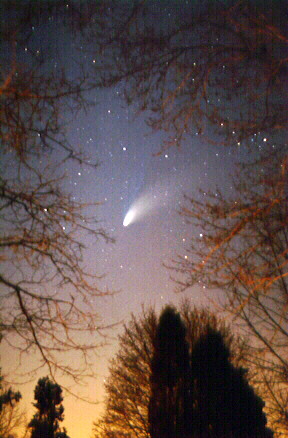
This is the OLD Hale-Bopp Gallery. I am starting to re-process archival images and have a New and Improved Hale Bopp Gallery started!
Hale-Bopp is now a memory for most of us, but it will almost certainly be remembered as "The Great Comet of 1997". Below is a sampling of some of my (Joe Roberts) best and most interesting photos of Hale-Bopp. These photos represent some of the best from nearly four hundred shots I took during the Hale-Bopp event. One comment I can make: getting great pictures of this comet was relatively easy! With only very modest equipment (and the right film), most anyone could have taken a decent shot of this comet. The color film technology has come a very long way in the last 5 to 10 years. Several of the shots below are very basic 30 second fixed tripod shots on Kodak Royal Gold 400 and 1000 film! Obtaining shots like these 20 years ago would have only been possible by advanced astrophotographers...
NOTE:For many more pictures of Hale-Bopp, visit the Amateur Astronomer's Notebook Photo Gallery!

This shot was taken from my backyard in Oakdale, CT USA on 14 April 97; a fairly fat Moon was in the sky at the time. 30 second fixed tripod exposure on Kodak Royal Gold 1000 film, 50mm F2.0 lens on a Pentax K1000 camera.

This photo was taken on the morning of 13 March 97. 30 second fixed tripod exposure on Kodak Royal Gold 1000, using a Pentax K1000 camera with a 50mm F2.0 lens. Time was about 4:30am EST; taken from my front yard in Oakdale, CT USA.

This photo was taken on the morning of 13 March 97. 30 second fixed tripod exposure on Kodak Royal Gold 1000, using a Pentax K1000 camera with a 50mm F2.0 lens. Tree was lit up for effect with a flash. The two "lines" in the upper right area of the photo are utility lines running to my house. Time was about 4:30am EST; taken from my front yard in Oakdale, CT USA.
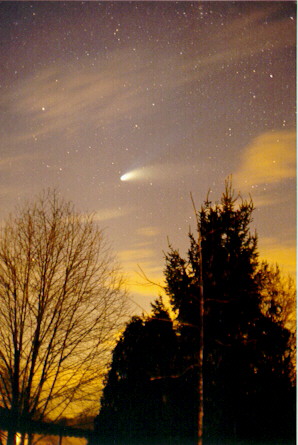
A beautiful sunset scene on 28 Mar 97. A few clouds can add so much to a scenic picture! This photo makes it look lighter outside than it actually was. 30 second fixed tripod shot on Kodak Royal Gold 400, 50mm lens @F2.0. Taken from my backyard in Oakdale, CT USA.

Here is a close up shot of the nucleus area of Hale-Bopp taken through a Celestron CG-11 telescope (with focal reducer yielding 1765mm @ F6.3). Note that the focal reducer causes some vigneting of the image in the tail area of the comet. Exposure was about 10 seconds on Fuji Super 800G film. Photo taken on 9 March 97 at about 5:00am EST (it was starting to get light out). I was hoping to capture some very interesting detail in the nucleus that looked like a series of "shock waves"; unfortunately even 5 second exposures burned out the film! The next picture does reveal the detail I was trying for. Taken from Blanford, MA USA.
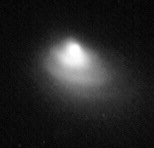
Here is a close up of the nucleus area of the comet taken with a Celestron CG-11 scope at 2800mm F10. This image is at a MUCH higher magnification than any other shot in this sampler. The exposure was made short in order to reveal the "shock wave" structure close in to the comet nucleus (long exposures "burned out" the inner detail). The film was Kodak Royal Gold 25 (yes, 25), exposure was about 5 seconds. The width of the nucleus of the comet on this exposure is about 10 arc minutes. Photo taken on 16 March 97 from Blanford, MA.
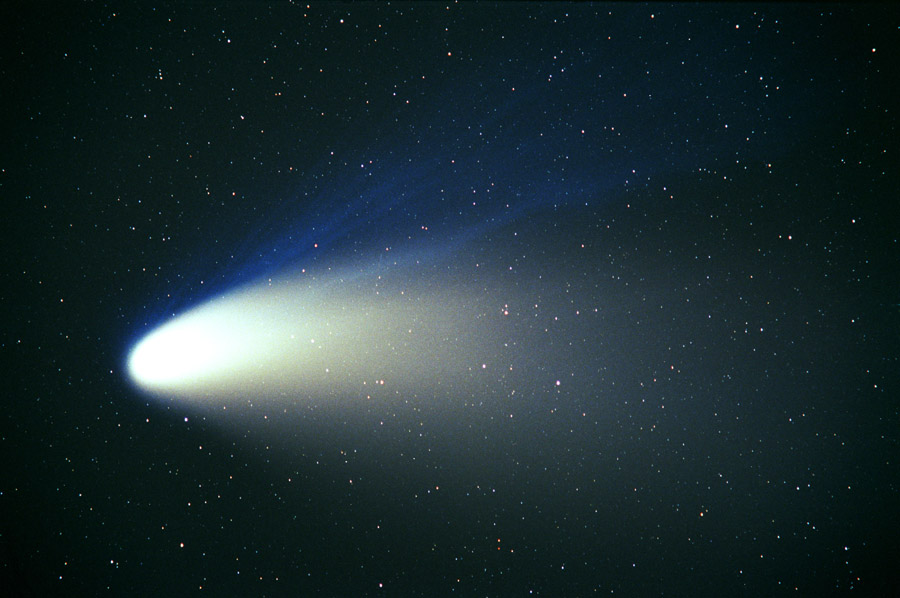
Here is what I consider my best shot of Hale Bopp. It was taken with a Vivitar 500mm F6.3 lens on Kodak Royal Gold 400 film. Five minute exposure from Salem, CT USA (which is an acceptable but not great site) on 4 April 97. Luckily the longer focal length lens seemed to "cut through" the relatively severe light pollution in the direction I was shooting. Guiding piggyback on Celestron CG-11.
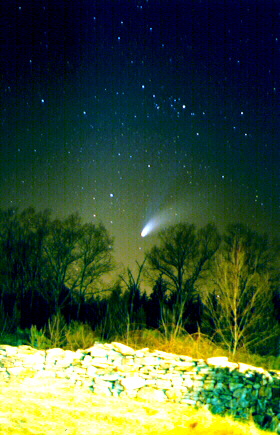
This scenic photo was taken from a site in Salem, CT USA (Rt 82) on 7 April 97. 30 second fixed tripod exposure on Fuji Super G800 film, 50mm F2.0 lens. Foreground was lit by streetlights behind the camera (the light pollution at this site is fairly bad).
Hale-Bopp, while still quite bright at magnitude 2 (as of 9 May), is now clearly past "primetime". I have shot 19 rolls of film thus far, which translates to about 350 photographs of the comet. Of these photos, there are about two dozen which are very good, a large number of "passable" shots, and at least 100 "duds". I may shoot one or two "goodbye" shots if the opportunity comes up, but on the whole I am more or less finished with Hale-Bopp my photo activities.
I have had the best results with Kodak Royal Gold film, in the 1000 and 400 speeds. I find that the 1000 is good for fixed tripod shots. I prefer the 400 speed for longer (telescope guided) exposures, but it also works well for fixed tripod shots. I tried the 200 speed but found that exposures necessary for a good "burn" were too long (8 minutes or more). Overall, I find that the Royal Gold 400 is the best grain/speed compromise. Fuji Super G 800 also works well, but often comes back with a strong green tint; I used the computer to "move" the color balance of some of the Fuji shots away from the green emphasis.
I would say the two biggest difficulties in my comet photography "adventures" were (1) air traffic, and (2) wind. One never realizes how many aircraft are in the sky until one tries to photograph a comet! I could rarely expose for longer than 4 minutes without having to stop an exposure due to an approaching plane! At one point I counted nine aircraft in the sky at once, and it was very common to have a half dozen planes in the sky constantly (until about 10:00pm). I'm sure that this is partially due to the locations of my photo sites (in the flight paths of airports in Boston, Providence, New York and Hartford). The second big problem was wind, which made it difficult to get good shots at longer focal lengths (like 500mm). On 7 April I had to deal with wind bursts of 30-40mph (while trying to shoot 500mm shots), which did affect the quality of star images on the prints. And then there were the usual problems, like clouds, light pollution, work, etc.!
One thing that still holds true (for me anyway)... the shots I thought for sure would be duds were sometimes the best of the lot! And, ones carefully planned out were often OK but not spectacular. Lesson learned? Try every option, take 3 or more shots for every angle, lens, film, etc. Take more shots than you think you need. Try shots in heavy twilight. Take as many shots as you can on a given night, since opportunities for "re-doing" a specific shot on a comet will never be available again.